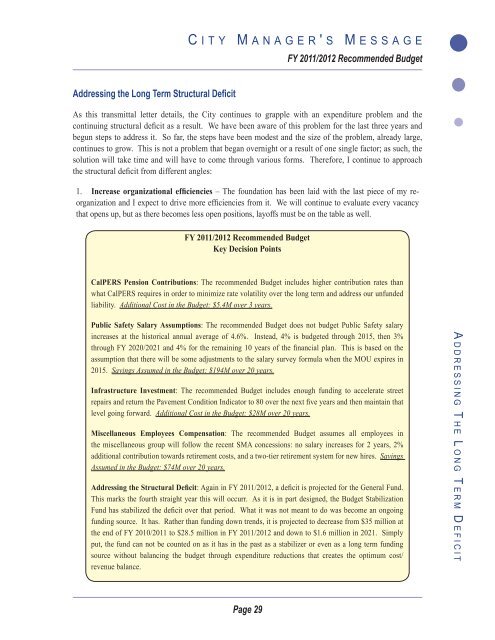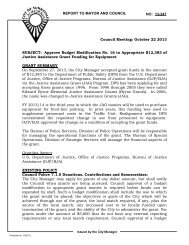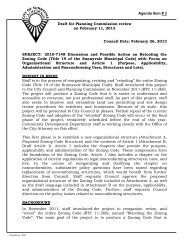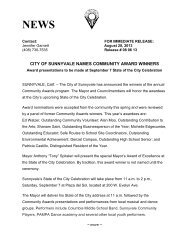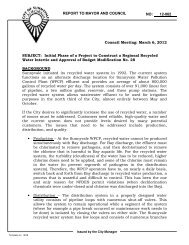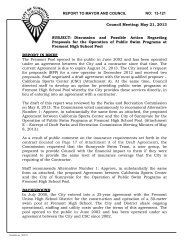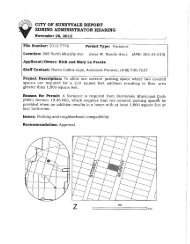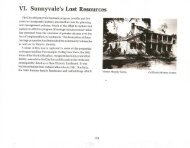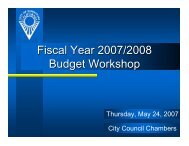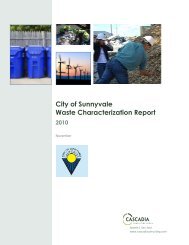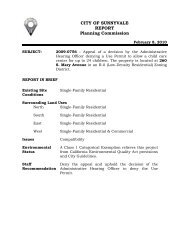20-Year Resource Allocation Plan - City of Sunnyvale
20-Year Resource Allocation Plan - City of Sunnyvale
20-Year Resource Allocation Plan - City of Sunnyvale
You also want an ePaper? Increase the reach of your titles
YUMPU automatically turns print PDFs into web optimized ePapers that Google loves.
Addressing the Long Term Structural Deficit<br />
C i t y M a n a g e r ' s M e s s a g e<br />
Page 29<br />
FY <strong>20</strong>11/<strong>20</strong>12 Recommended Budget<br />
As this transmittal letter details, the <strong>City</strong> continues to grapple with an expenditure problem and the<br />
continuing structural deficit as a result. We have been aware <strong>of</strong> this problem for the last three years and<br />
begun steps to address it. So far, the steps have been modest and the size <strong>of</strong> the problem, already large,<br />
continues to grow. This is not a problem that began overnight or a result <strong>of</strong> one single factor; as such, the<br />
solution will take time and will have to come through various forms. Therefore, I continue to approach<br />
the structural deficit from different angles:<br />
1. Increase organizational efficiencies – The foundation has been laid with the last piece <strong>of</strong> my reorganization<br />
and I expect to drive more efficiencies from it. We will continue to evaluate every vacancy<br />
that opens up, but as there becomes less open positions, lay<strong>of</strong>fs must be on the table as well.<br />
FY <strong>20</strong>11/<strong>20</strong>12 Recommended Budget<br />
Key Decision Points<br />
CalPERS Pension Contributions: The recommended Budget includes higher contribution rates than<br />
what CalPERS requires in order to minimize rate volatility over the long term and address our unfunded<br />
liability. Additional Cost in the Budget: $5.4M over 3 years.<br />
Public Safety Salary Assumptions: The recommended Budget does not budget Public Safety salary<br />
increases at the historical annual average <strong>of</strong> 4.6%. Instead, 4% is budgeted through <strong>20</strong>15, then 3%<br />
through FY <strong>20</strong><strong>20</strong>/<strong>20</strong>21 and 4% for the remaining 10 years <strong>of</strong> the financial plan. This is based on the<br />
assumption that there will be some adjustments to the salary survey formula when the MOU expires in<br />
<strong>20</strong>15. Savings Assumed in the Budget: $194M over <strong>20</strong> years.<br />
Infrastructure Investment: The recommended Budget includes enough funding to accelerate street<br />
repairs and return the Pavement Condition Indicator to 80 over the next five years and then maintain that<br />
level going forward. Additional Cost in the Budget: $28M over <strong>20</strong> years.<br />
Miscellaneous Employees Compensation: The recommended Budget assumes all employees in<br />
the miscellaneous group will follow the recent SMA concessions: no salary increases for 2 years, 2%<br />
additional contribution towards retirement costs, and a two-tier retirement system for new hires. Savings<br />
Assumed in the Budget: $74M over <strong>20</strong> years.<br />
Addressing the Structural Deficit: Again in FY <strong>20</strong>11/<strong>20</strong>12, a deficit is projected for the General Fund.<br />
This marks the fourth straight year this will occurr. As it is in part designed, the Budget Stabilization<br />
Fund has stabilized the deficit over that period. What it was not meant to do was become an ongoing<br />
funding source. It has. Rather than funding down trends, it is projected to decrease from $35 million at<br />
the end <strong>of</strong> FY <strong>20</strong>10/<strong>20</strong>11 to $28.5 million in FY <strong>20</strong>11/<strong>20</strong>12 and down to $1.6 million in <strong>20</strong>21. Simply<br />
put, the fund can not be counted on as it has in the past as a stabilizer or even as a long term funding<br />
source without balancing the budget through expenditure reductions that creates the optimum cost/<br />
revenue balance.<br />
A D D R E S S I N G T H E L O N G T E R M D E F I C I T


